Tracking Border Ghosts with Ronen Eidelman

[Image: The Ghost of Manshia, Jaffa, Israel, 2007. Photo and installation by Ronen.]
I remember when I found Ronen’s project (un)Documented Disappearance back in March I was blown away. I thought it made crucial reflections on migratory space today, filling the street drains of Europe with images and documents of refugees and immigrants trapped in the gutter, being washed away like trash in a perpetual stir under everyone's feet, conjuring this kind of urban consciousness about migrant struggles as they ghosted past in the peripheries of our street-wandering eyes.
Well, his latest project is an awakening of the ghost of Manshia, a coastal Israeli city known today as Jaffa that was garrisoned from the Arabs back in 1947. This time Ronen has outlined with chalk the old boundaries of the Arab neighborhood just south of Tel Aviv before it was transformed by the Israelis.
I love this project for many reasons but mostly because of the way Ronen understands borders as outlines of memory, as ephemeral bodies in themselves, and not merely lines of state power.
Segueing nicely from my last chat with Jay Isenberg about the Israeli Security Wall and his future plans to retrace "the spaces of the uninhabited" along a "pilgrimage of hope" somewhere near the Israeli/Palestinian border, Ronen and I recently talked about his work as a public artist, his skepticism of archeology, what he hopes to achieve as a ghost chaser and No Borders activist, and different ways public art in the form of direct action can subvert the political regimes that cement themselves in structures like border walls.
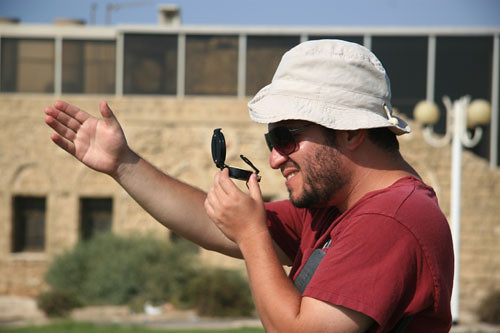
[Bryan Finoki] I'm curious when did you first learn about the history of Manshia and what originally compelled you to do this project?
[Ronen Eidelman] I've been living in Jaffa and south Tel Aviv for over ten years so I have become well aware of the many destroyed Arab neighborhoods in the area I've been living. The history is very visual, you can see the old Arab homes and the old Arab names that are still used by many people today. I learnt the more precise history of Manshia from the wonderful book by the architect Sharon Rotbard, White City, Black City. The book provides a social, economical and political history of Tel Aviv and Jaffa through architecture and city planning and presents an alternative to the Zionist narrative that I grew up on. Reading Rotbard's book really strengthened my desire to discuss publicly the dark history of Tel Aviv. So when the Ayam Association initiated The Autobiography of a City project and approached me to suggest a project dealing with the memory of Jaffa I was very exited. I'm motivated mostly by exploring political art in public space and this was an opportunity for me to work in my own neighborhood.
Was there a precise aim or intended experience you were trying to generate with this, or was it more intended to overlay the past onto the present and just see what sorts of responses might naturally be triggered from that?
Approaching the project I asked myself how I could resurface the past without destroying the present. In archeology to expose and learn of the past you must destroy the present layer. I grew up in Jerusalem and became very resentful of archeology because I saw how it's been used as a political tool and how these reminiscences of the past make life in the present almost impossible.
How so, what do you mean exactly?
On the first level - the clear physical level – if the whole area is dug up and ruins are exposed all life on the top level disappears and what is created is what is called an archeological garden, which is an outdoor museum of ruins. Because these digs serve the political purpose of proving that the Jewish life in Jerusalem existed previously to the Arab life, exposing the past becomes more important than the rights of the living. A neighborhood can be destroyed in order to dig underneath it. But, on a more theoretical level it can also make life impossible. When the political debate and arguments are only occupied in proving past rights and possessions of land it can leave no place for discussing future solutions for a just and peaceful life in the city.
So, I wanted to keep the park as the living place, to not disturb the vibrant life that the park already holds. But at the same time I wanted to create a situation for the visitors to learn what lies under the grass. Most Tel Avivers still believe in the myth that the city was just born from the sand a hundred years ago as a Modern Hebrew city. Through this project I wanted to illustrate that Tel Aviv was born from Jaffa and portray the Arab history of the city in an easy to digest but honest and clear way.
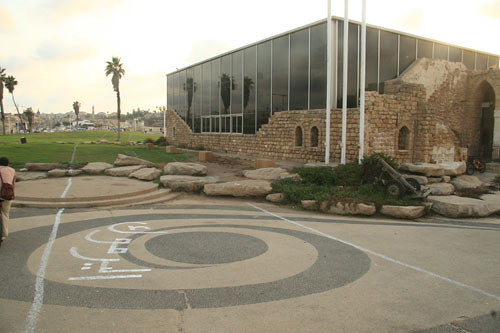
There is a poetic and therapeutic quality in the release of a repressed history from the maw of all that has fallen upon it since it destruction. As with most public art installations there is a degree of attention that is specifically called to the site, but in this case the site itself is the installation.
Getting at the territorial fossils and urban erasure that come and go through history, and the ways memory is stored or censored in the landscape, I'd like to hear your thoughts on how certain narratives of injustice are both embedded in landscapes but also how those same narratives of power can be unraveled through public art? How do you see your work in relation to place, in particular its role in revealing the hidden contexts of the site?
Standing at the site with knowledge of the past makes the surrounding history become very clear, you can see the Hasan Beck Mosque, the Turkish Train Station, the Etzel House (the only three buildings still standing) in this unnatural city fabric. The erasure and destruction is very obvious but completely un-felt. Because the site is a park on the beach it's a place of leisure and pleasure and has a much stronger identity now that way. It's very different from many places that symbolize the injustice like destroyed villages and graveyards, or even the rundown neglected poor neighborhoods you find in other parts of Jaffa.
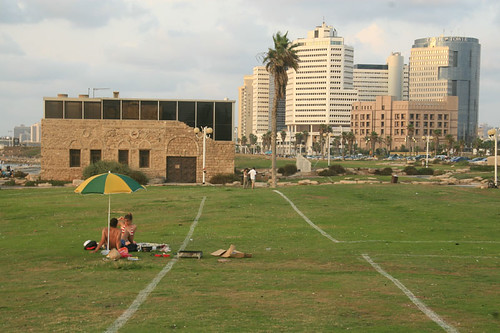
The people coming to the site are in a good mood and come here to relax. Those who randomly visited the site were more open to listen and have discussions with us. The majority of the people who where exposed to the project had no idea of the actual history and were quite surprised when they learned where they were standing – but understood very quickly. This I felt was extremely important – they did not come to a memorial or make a special trip, they were confronted with the past simply on their way to the beach or to have an innocent picnic.
Many of the older people in Jaffa and Tel Aviv have forgotten about the neighborhood of Manshia or just never stopped to grasp where they were standing. But once they realized what we were marking on the ground many of them got nostalgic and told us their memories of the area. One day we were approached by some old men who were members of the Etzel (Irgun) paramilitary group that conquered and destroyed Manshia in 1947. One of the men fought in the very place we were standing at that moment and even pulled up his pants to show me his bullet wounds. In the beginning he was very aggressive, attacking us and literally trying to stop us from working. But, as the conversation grew deeper he saw the seriousness of our research and how we were basing the project and he finally chilled out a bit. It was amazing though hearing this oral history from him as he pointed out actual places nearby where battles and tragedy had occurred. What was very interesting was that he did not deny crimes were ever done or that the Arab population was expelled, he just kept insisting that our project would provide more ammunition for "our enemies and just like when you shit you don't do it public so we should not talk about our crimes in public."


I am obsessed with borders, as you probably know; their legacies, impacts, histories, production and so forth. One thing I find most intriguing about your project is this conjuring of ghosted borders; borders that may have been forgotten but still persist in some way or to some people. Or, perhaps even the opposite: borders that still exist but have somehow been forgotten.
The notion of unmasking hidden borders, uncovering their lost significance, political pasts, and superimposing them over contemporary contexts is always fascinating to me. Especially today given the intense erosion of the nation state and the global trend to harden geographical boundaries, the projected cartographies of post-empire landscapes, yada yada yada.
But I am intrigued by how we archive and recall a place's unique history – and the implication that a border is something much greater than a physical, geographic, spatial, or political boundary. There are so many dimensions to what actually constitutes a border.
Anyway, how does this project reflect on the regional evolution of making and remaking contested borders? What does it suggest about the ways borders linger and persist in our consciousness, in the form of things not built?
I chose to mark the lines of the borders in a football field because I find the idea of the football lines very fascinating. The lines and markings on that field have to be clear but they cannot disturb movement. The players must notice them, listen and watch out for them, but they cannot become physical obstacles in any way. If the players respect these borders and obey the rules the game will work because the players are completely free to move in and out of the borders (only the ball can't leave). However, playing with this similar notion, I see the project more of a marking of memory than a marking of borders – like the chalk line outlining the body of a murder victim. It is a sign that a crime has been committed in that very spot, even though the body has been removed the memory of the crime is still very present. When you look at the maps before 1948 of the borders between Jaffa and Tel Aviv they were very clear, but in talking to the people who lived on the municipal borders they gave them very little importance – borders were permeable sort of like they are on the football field. There were Arabs living on the Tel Aviv side and Jews Living in Jaffa. I'm not claiming that they were in harmony and there weren't any conflicts but they were neighbors who shared food, looked after each other's children, and of course did business together. So I'm not interested in redrawing the borders and claiming parts of Tel Aviv as Arab, what I'm interested in is the Idea of the potential of living together like they did before 1948.
So, with the project I wanted to blur these different definitions of borders: as permeable and shared boundary markers, as imprints of forgotten lives, as a neighborhood zone of new potential to live amongst each other in spaces of border overlap.
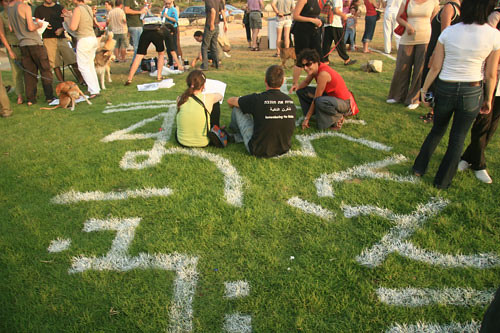
Aside from the old paramilitary members, was there any resistance to this project from official bodies, or was it rather widely supported? Did the production itself bring people together from across barriers; did it cause conflict; or was it relatively benign? I'm curious not only about what the project in the end provokes but what comes up during the project's development. You’ve spoken to some of this already but what were the types of public responses or dialogs that emerged along the way? Did you yourself stumble upon any surprises as a result? What have you learned?
The project was supported both financially and logistically by The Tel Aviv Jaffa Municipality. I was surprised they agreed to support us but was also very happy. I guess Tel Aviv feels strongly enough today to confront its dark history. Sharon Rotbard thinks that the reason for the acceptance of this discourse (his book is very popular) is that its sexy for a city to have a dark history, nobody wants to be the geek who just built nice modernistic white houses on the sands. To be honest I don't think the people in the culture office at the municipality deeply understood all the aspects of the project and just saw it as a nice way for Jewish and Arab residents to do a nice cultural project together. I was surprised from the response and the level of dialogue that went on with the passersbys during the days of the marking. People really engaged themselves with the project, studied the maps we distributed and asked many questions. Of course some people called us traitors and cursed at us but it was really minimal compared to what I actually expected might happen.
There was not as much denial of history, or lack of historic context coming from the public. The facts around the forceful expulsion of Arabs from Jaffa are rarely contested. Most of the arguments were whether it had to be done or not, if there was no choice for Tel Aviv but to defend itself through offense. Some of the old Jewish people were describing in detail their life of fear living in small Tel Aviv and being attacked from the Iraqi and Egyptian armies who were heading towards Tel Aviv. It was amazing how they were still living pre-‘48 fears when there was no state to protect them and how their fears still make them so fragile even though Israel is a military superpower and Tel Aviv is a rich dominant city. It’s so crazy that the politics are still based on the battles and wars of yesterday even though the reality is so different.
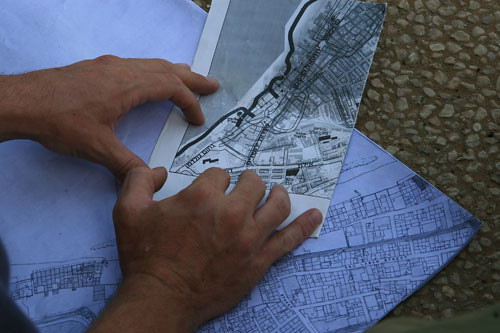

I am reminded of the work of Francis Alÿs who walked through Jerusalem and large parts of the West Bank with cans of green spray paint that he used to retrace the Green Line and show the discrepancies of how it has been (un)observed by Israel's territorial expansion. Did that piece have any influence on your work here, or have any other similar projects around border revival? How did you first get into public art and these types of landscape resurrections, if I may call them that?
I'm familiar with the work of Francis Alÿs but like I was saying before not interested in marking borders, as an anarchist I try not to give importance to state lines. My work is much more influenced by projects that deal with memory and that explore the life that was destroyed from state violence. A big inspiration is Zochrot, a group of Israeli citizens working to raise awareness of the Nakba, the Palestinian catastrophe of 1948. They do all sorts of creative actions like changing street signs back to their original pre nakba names. I come from an activist background and for many years I've been active in anti occupation and anti capitalist groups, mainly Anarchists Against the Wall. But, with time I came to learn the limitations of political work. Now, through art I hope to examine and question my world in a fresh and stirring way, and move beyond the obvious and all the clichés. The political power structure today makes it almost impossible to influence change on the ground, especially in the short term. But culture is always a step ahead of politics. If we can influence the culture then later perhaps the political process will follow. So through my projects of art and other forms of cultural production I use the experience and tactics that I’ve acquired through my political work. The political and the artistic share an invaluable relationship. In direct action you confront the problem at the place where it exists. In a similar way of thinking I like to confront the power structures, the leading public perceptions, shed light in places where it's most effective and challenge the people to become more aware of and critique the place where it’s happening. Hopefully my art helps to instigate this way of engaging place.
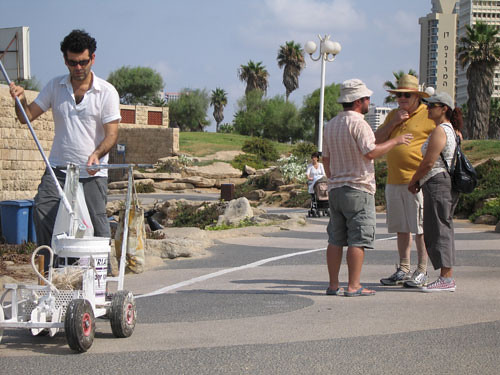
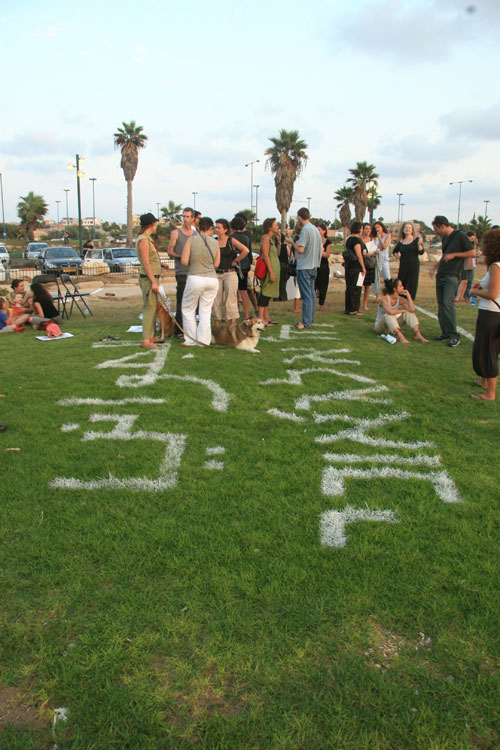
How long did the ghost of Manshia remain evident? I like the choice of white chalk to evidence the ghost, too – an essentially temporary and ephemeral material. Was that an intentional way of suggesting the fleeting nature of border, the ashen remains? Did the chalk lines dissolve on their own? Or, was the use of chalk more motivated by your desire to materialize the old border in a way that wouldn't obstruct the soccer field so both could co-exist peacefully in the present? Is that then a comment on how borders can exist overlapping simultaneously, and how perhaps a single border can be acknowledged differently depending on which side you are standing?
Maybe I am reading too much into it but I think the project has done an excellent job of being all of these dimensions of border in a single moment.
There are still some remnants of the markings but most of the lines started to disappear after three weeks. Like my project in Jena I choose to make projects that don’t last. I don’t feel it's my job to create monuments. I like to raise questions and to shed light on dark places, but once the discussion starts I feel the art should step aside and let the life of the project itself take over. Political art that overstays its relevance can get pathetic. Borders change all the time, and they should – its great the different cultures and populations are always in transit and change just as long as it’s done voluntarily.
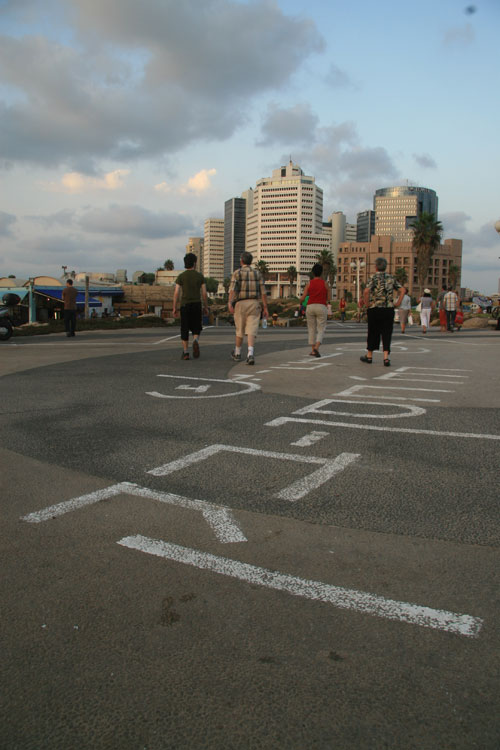
What other sites did you consider, if any? I mean it would be incredible (be it totally unfeasible) to conduct this same type of border resurfacing with all of the borders that have undergone radical transformations over time in the region. Imagine an entire landscape marked in the chalky delineations of its geographical past. Perhaps this could launch an ongoing project that encourages local residents to research the disputed boundaries of their locale's past and share in the redrawn recollection of them. A massive web archive with aerial photography could begin to catalog them, so that eventually we have the entire suspect boundary evolution retraced, revived from the dead?
I don't know – call me crazy that might be ridiculously unrealistic.
But, in some ways the Ghost of Manshia is an inversion of your previous project, (un)Documented Disappearance. In that project you used the sewage gutters and existing cracks in the city's urban fabric as a means to call attention to the crisis of borders and the shadowy spaces of migration. In this recent project however you redrew the borders that were no longer visible as another way of creating public consciousness about these forgotten populations of people, place, and culture that have been pushed underground.
I guess finally my question is: where might you take this theme next? Are you working on any future projects that will continue to illuminate the border?
Sadly, there are many other places I could easily consider for a similar project not only in Jaffa, or Israel/Palestine, but all over the world. On one of the days we were marking I started arguing with a man who did not like the project and he said, "Why don't you go and mark the destroyed Jewish neighborhoods in Iraq?" And I told him that I would love to, but unfortunately it’s not possible these days, and that ultimately it’s the responsibility of the Iraqis to reconcile their history of the Iraqi-Jewish expulsion. Then he asked me, are the Germans or Polish marking the Jewish quarters in their towns? I told him yes and that I know of dozens of really good projects in Germany and many artists who are dealing in a serious way with the tragic Jewish history in their country. I added that I'm not familiar with Poland but assume that young Polish artists are also doing projects.
Anyway, the next day I got an email from a Polish artist, Kasia Krakowiak saying that she had visited my project and would like to meet me because she is working on a similar project in Warsaw about the Jewish ghetto. Krakowiak, with Dr. Muto and Maciek Ozog have created a platform that uses cellular technology to recreate the borders of the Warsaw ghetto. The participants who agreed to have their phones tracked received text messages on their phones that metaphorically related to the walled Jewish district as they entered the boundaries of what was once the ghetto. This project was conducted back in September of this year (just before Manshia) and was very successful. But Krakowiak still felt that the borders of the Ghetto needed a more physical marking. Even though the participants in Ashaver 220 volunteered to be texted when entering the Ghetto what I like about this is that through a different kind of bordering you can also confront those people who don’t even ask to know the history of a place, or its old political boundaries. After meeting with Kasia Krakowiak we have agreed to work together to more physically mark the borders of the Warsaw Ghetto, which makes a great juxtaposition with her mobile phone driven border mapping. We haven’t decided yet how this will be done exactly but we are meeting next month to advance this important, exciting and terrifying project.

Politically speaking, what is your take on the current trend in global bordering that is going on (especially in context of the war on terror) and its relation to the global economy? What is your opinion of the Israeli Security Wall, or the controversial border fence along the U.S.-Mexico boundary? Or any of the heavily fortified stopgaps severing the tides of mass migration from the land of opportunity (Morocco/Spain, South Asia/Australia, Romania/Central Asia, Kashmir, Taiwan, NK/China, etc)?
How do we begin to unborder the world?
I'm clearly against borders and for freedom of movement for everyone. I feel part of a movement that is also a community. My opposition to the Wall in Palestine comes also from self-interest; I feel that if I want a future in the Middle East as an Israeli Jew I need to fight against this criminal wall. The wall is ghettoizing me and creating a never-ending cycle of war and violence. But I also understand that this wall is part of a bigger picture. The walls between the US and Mexico, the walls around the EU, and the walls being built in the cities between the rich and poor neighborhoods all over the world. I went to the No Border Camp in Ukraine because the eastern fence of the EU is also my struggle. At the camp I met people I knew from previous struggles I had participated in Palestine and Germany and I don’t think it was by any accident we rejoined. We are already unbordering the world through the old fashion concept of international solidarity. We first do it in our minds, but then also physically by just crossing. I’ve been to Palestine many times even though its illegal for Israelis, but it’s a small price to pay compared to the Palestinians. Mostly I think it’s an important act of solidarity. And when we were in Ukraine we marched to the Slovakian border and held a rally in front of the main immigrant prison there.
Art projects are a part of an entire campaign that includes direct actions, border smuggling, solidarity, education, legal action, academic work, demonstrations, writing, video, parties and so much more. None of these actions stand alone but are part of a global network that is building a massive community of immigrants, refugees and privileged "good" passport holders like myself, who all believe together that we can destroy all of these borders from bellow.
[All images from The Ghost of Manshia, Jaffa, Israel, 2007, by Ronen.]







2 Comments:
Nice Project...
Fantastic interview, thank you both.
Ronen - I encountered your project on my weekly walks along the beach, and found myself spontaneously tracing a different path in relation to the ghost-lines.
Alongside the aesthetic interest that it created, I admit that I had - still have - some reservations about the work - in that it recontextualizes the area, but in a very particular context... i.e., the Israeli expulsion of the Arabic neighborhood. When, of course, the larger historical context is so much more complex and diverse.
So, I was happy to read about your projects in other parts of the world as it is important to juxtapose different histories and different times to come to a fuller view of how borders are part of the fabric of history.
I do wonder whether the 'pre-48 fears' are really so very far away and irrelevant, or if they haven't been repeated so often they have become repressed and re-represented. Driven underground and come up in a different way, for example in the form of your political art (and therefore perhaps no coincidence that it raised the ghost of those very "far away and irrelevant fears").
I would like to agree with you that it's possible to think about moving freely without relation to our history and buried fears - and ultimately free of borders.
Though, at this point, it seems we're still figuring out how to release ourselves from this dialectic between the large, concrete, economically and politically motivated and debilitating walls and the anarchic impulse to revise, review, renew, resurface different borders and forms of movement.
So I'll leave the question of the possibility of deconstructing movement from borders for another time :)
Post a Comment
<< Home